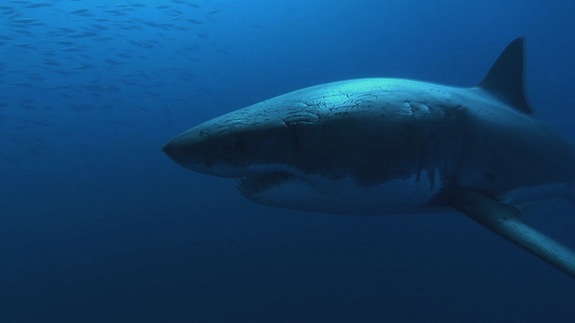Track a Great White Shark from Your Computer
Where in the world are Genie and Mary Lee? Two tagged great whites are teaching us about how these giant fish live in the deep

Image: KQED
If you want to know what a shark is doing, you’re generally out of luck. Unless you’re Chris Fischer that is. Fischer recently caught a couple of great white sharks—no big deal or anything—and attached GPS tags to them. One of them was a 2,292 pound female; another was a whopping 3,456 pounds. Now they’re swimming about in the deep with these trackers on them. And you can track them on your computer at home.
Now, as you might imagine, putting those tags on great whites isn’t easy. Fischer has to catch them, haul them up onto the boat and attach the device to their dorsal fin. And that whole process has him in trouble with other researchers. The New York Times writes:
For some environmentalists, the mission is not so benign, or even necessary. They see the live capture of sharks as more invasive than other methods of tagging, like using a harpoon to implant a tracking device. The great whites are already a protected species in the United States, they argue, and the use of hooks and a method that exhausts them before pulling them out of the water subjects them to unnecessary trauma. During the South African expedition, one shark died.
In fact, there’s a petition to deny Fischer permits to do his work, and it was signed by 750 people. But, in the end, Fischer got his permit and tagged his sharks. For him, this whole question is silly. The alternative methods of tagging sharks, like harpooning them with sensors, simply aren’t reliable enough. The New York Times writes:
For example, he said, tags implanted on sharks through harpooning are less reliable than those attached to the fin because they can fall off after six months and they emit a signal only if receivers are placed in the water around them. It is impossible to know where the sharks are going, he said, and therefore impossible to plant receivers everywhere they might go. By contrast, he said, when sharks are captured, the GPS tags can be attached securely with a drill. They are read by satellites every time the fin breaks the surface of the water and can emit signals for five years.
And scientists have studied the stress that sharks go through after tagging and concluded that after a few hours they are completely recovered.
The two tagged sharks, named Genie and Mary Lee, are now swimming about and showing us their deep, dark secrets.
More from Smithsonian.com:
Shark Teeth Have Built-in Toothpaste
Stopping Sharks by Blasting Their Senses
/https://tf-cmsv2-smithsonianmag-media.s3.amazonaws.com/accounts/headshot/Rose-Eveleth-240.jpg)
/https://tf-cmsv2-smithsonianmag-media.s3.amazonaws.com/accounts/headshot/Rose-Eveleth-240.jpg)